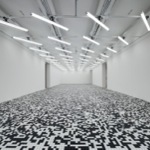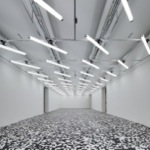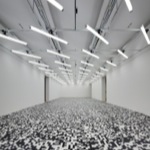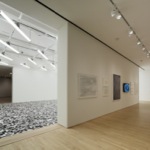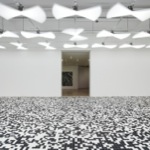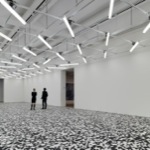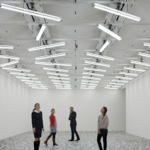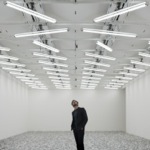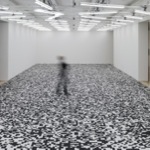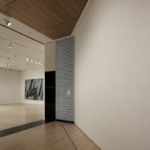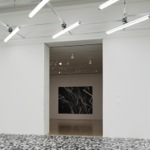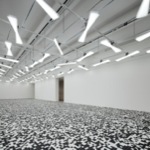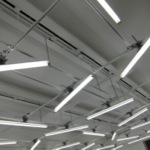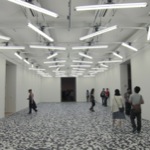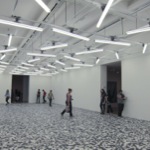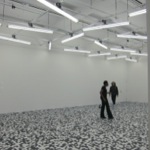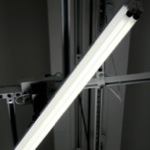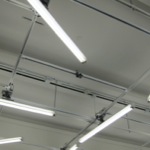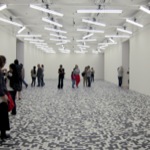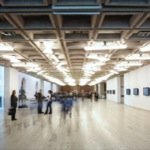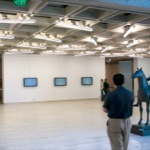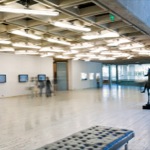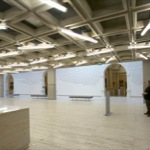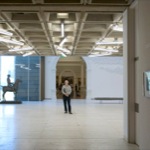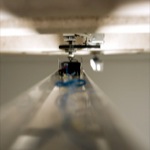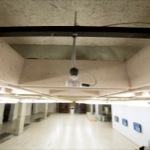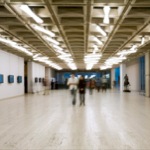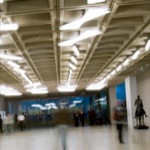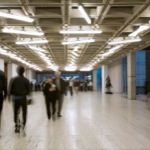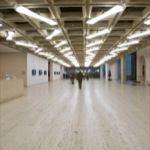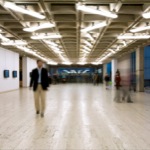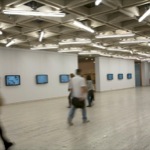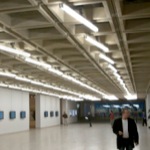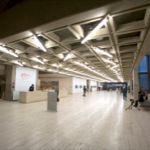Homographies
Subsculpture 7
"Homographies" (Subsculpture 7) is a large-scale interactive installation featuring a turbulent light array that responds to the movement of the public using a surveillance tracking system. The installation consists of white fluorescent light tubes hung from robotic fixtures on the ceiling of the exhibition space, equally spaced. Each light tube rotates slowly using a computerized stepper motor and create labyrinthine patterns of light that make "paths" or "corridors" between people. All lights are always on and typically constitute the only lighting in the exhibition hall, except for the natural light that spills into the space.
The piece uses a surveillance tracking system with tiny panoptic cameras placed on the ceiling; these detect the presence and position of people in the exhibition space. As participants walk through, the system automatically rotates the light tubes very slowly to create labyrinthine patterns of light that are "paths" or "corridors" between people. In "Homographies", the "vanishing point" is not architectural, but rather connective; it is determined by who is there at any given time and varies accordingly. This produces a reconfigurable light-space that is based on flow, on motion, on lines of sight, an intended contrast to the cartesian grids that organize most modern architecture.
The fluorescent light tube is found in most default architectural spaces: offices, schools, hospitals, museums, prisons, factories. The ubiquitous presence of these strip lights refer to our cold experience with architectural normalization, namely homogenization and globalization. Very often, fluorescents line-up and index a direction, especially when found in corridors. "Homographies" attempts to pervert that linearity and "privileged point of view" and instead offer a plurality of points of contact.
The piece was originally developed for the Entrance Court of the Art Gallery of New South Wales (AGNSW) and exhibited at the Sydney Biennale 2006.
The piece uses a surveillance tracking system with tiny panoptic cameras placed on the ceiling; these detect the presence and position of people in the exhibition space. As participants walk through, the system automatically rotates the light tubes very slowly to create labyrinthine patterns of light that are "paths" or "corridors" between people. In "Homographies", the "vanishing point" is not architectural, but rather connective; it is determined by who is there at any given time and varies accordingly. This produces a reconfigurable light-space that is based on flow, on motion, on lines of sight, an intended contrast to the cartesian grids that organize most modern architecture.
The fluorescent light tube is found in most default architectural spaces: offices, schools, hospitals, museums, prisons, factories. The ubiquitous presence of these strip lights refer to our cold experience with architectural normalization, namely homogenization and globalization. Very often, fluorescents line-up and index a direction, especially when found in corridors. "Homographies" attempts to pervert that linearity and "privileged point of view" and instead offer a plurality of points of contact.
The piece was originally developed for the Entrance Court of the Art Gallery of New South Wales (AGNSW) and exhibited at the Sydney Biennale 2006.
General info
Spanish name:
Homografías
Year of creation:
2006
24 fixtures version
Technique:
24 motorized light tubes, 48 fluorescent tubes, computerized surveillance tracking systems, and custom software
Dimensions:
Each light tube is 1.83 m long, the artwork can cover an area of between 240 and 420 sq m
Edition:
3 Editions, 1 AP
Collectors:
Art Gallery of Ontario and private collector
72 fixtures version
Technique:
72 motorized light fixtures, 144 fluorescent tubes, computerized surveillance tracking systems, and custom software
Dimensions:
Each light is 1.83 m long, the artwork can cover an area of between 240 and 420 sq m
Edition:
1 Edition, 1 AP
Exhibitions
- Field Conditions, San Francisco Museum of Modern Art, San Francisco, California, United States, 2012 - 2013.
- Sculpture as time, Art Gallery of Ontario, Toronto, Ontario, Canada, 2010.
- Art Basel Unlimited - Art Basel 38, Galería OMR, Galerie Guy Bärtschi and bitforms gallery, Basel, Switzerland, 2007.
- Floating Artworks, TD Centre, Art Gallery of Ontario, Toronto, Ontario, Canada, 2007.
- Zones of Contact, Biennale of Sydney, Art Gallery of New South Wales, Sydney, Australia, 2006.
Credits
- Production and Programming Assistance: Conroy Badger, Matt Biederman, Sandra Badger, Natalie Bouchard, Will Bauer
Bibliography
- "10 Mexicanos en Art Basel." MXCITY, Nov. 2016. Mexico City, México, 2016. (español) (Websites)
- "Field Conditions." SFMOMA Open Space Blog, 30 Oct. 2012. San Francisco, California, United States, 2013. (english) (Websites)
- "Media+Architecture." Cluster, 2008. Torino, Italy. (english and italiano) (Magazines)
 Cohn, Terri. "San Francisco Rafael Lozano-Hemmer." Art in America, Apr. 2012, 155-156. New York City, New York, United States, 2013. (english) (Magazines)
Cohn, Terri. "San Francisco Rafael Lozano-Hemmer." Art in America, Apr. 2012, 155-156. New York City, New York, United States, 2013. (english) (Magazines) Druckrey, Timothy. "Bodies, voices, pulses, traces, profanations...." Rafael Lozano-Hemmer: Recorders, exhibition catalogue, Manchester Art Gallery, 2010. Manchester, United Kingdom. (english) (Books)
Druckrey, Timothy. "Bodies, voices, pulses, traces, profanations...." Rafael Lozano-Hemmer: Recorders, exhibition catalogue, Manchester Art Gallery, 2010. Manchester, United Kingdom. (english) (Books) Flores, Tatiana. "The Historical (Self-) Conciousness." ArtNexus, Vol.7, No.71, May 2010. Madrid, Spain. (english) (Magazines)
Flores, Tatiana. "The Historical (Self-) Conciousness." ArtNexus, Vol.7, No.71, May 2010. Madrid, Spain. (english) (Magazines)- Macfarlane, David and Nigel Dickson. "Surprised by art." McClelland & Stewart Ltd., 2011. Toronto, Ontario, Canada. (english) (Books)
- Mugnier, Patrice, Kuei Yu Ho. "Homographies: Rafael Lozano-Hemmer." Design Interactif, 2012. Saint-Germain, France. (français) (Books)
 Ozog, Maciej. "Surveilling the surveillance society: the case of Rafael Lozano-Hemmer's installations." Conspiracy dwellings: Surveillance in Contemporary Art, 2010. Newcastle, United Kingdom. (english) (Books)
Ozog, Maciej. "Surveilling the surveillance society: the case of Rafael Lozano-Hemmer's installations." Conspiracy dwellings: Surveillance in Contemporary Art, 2010. Newcastle, United Kingdom. (english) (Books)- Ponzini, Monica. "Lozano-Hemmer: Relational Architecture." Digimag (Milano), issue 28, Oct. 2007. Italy. (italiano) (Websites)
 Sánchez Balmisa, Alberto. "Rafael Lozano-Hemmer." 100 Artistas Latinoamericanos ‒ Latin American Artists, 2006. Madrid, Spain. (english and español) (Books)
Sánchez Balmisa, Alberto. "Rafael Lozano-Hemmer." 100 Artistas Latinoamericanos ‒ Latin American Artists, 2006. Madrid, Spain. (english and español) (Books)- Wilson, Stephen. "Art Science Now." Thames & Hudson Inc., 2010. New York City, New York, United States. (english) (Books)
Photo Library (click to expand)
